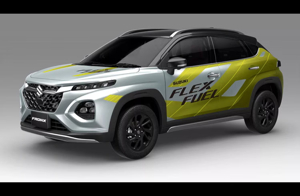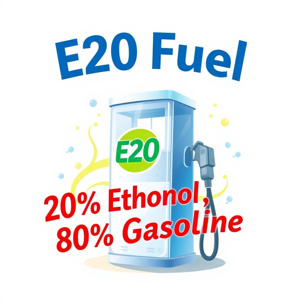
The Maruti Fronx Flex Fuel SUV has been officially revealed ahead of its global debut, which will take place at the Japan Mobility Show 2025 from October 29 to November 9. The Fronx Flex Fuel Concept brings Maruti Suzuki’s alternative fuel ambitions to the forefront, showcasing a tweaked 1.2-litre petrol engine capable of running on ethanol blends from E20 up to E85, similar to the powertrain used in the Wagon R Flex-Fuel concept.
Key Highlights
- The Fronx Flex Fuel is visually almost identical to the standard ICE-powered Fronx, with its main differences being special flex-fuel decals and graphics to distinguish it at the expo. Expect details like yellow stickers and possibly a specific flex-fuel badge on the production model’s tailgate.
- The official engine details remain under wraps, but both Suzuki’s 1.2L and 1.5L petrol engines are compatible with flex-fuel technology and are likely candidates for Indian and global versions.
- The Fronx Flex Fuel will debut as a concept at the Japan Mobility Show, with the production-ready version expected for launch in India by March 2026.
- Maruti Suzuki is pushing a multi-pathway approach towards sustainability, investing not only in flex-fuel but also in compressed bio gas (CBG), battery electric vehicles (BEVs), and hybrid powertrains, with the latter reported to deliver over 35 kmpl in future models.
- The flex fuel Fronx concept is part of Suzuki’s broader effort to offer affordable, low-emission vehicles alongside electric and hybrid options for the Indian market and beyond.
Design & Features
- No major design changes from the standard Fronx other than decals and stickers.
- Maintains bold SUV styling with the same bumpers, cladding, alloy wheels, split headlamps, rising waistline, and sloping roofline.
- Advanced driver assistance features like ADAS are suggested for upcoming hybrid versions, though not confirmed for the flex fuel concept yet.
Market & Launch
- The Maruti Fronx Flex Fuel’s India launch is anticipated for 2026, with the company also preparing to introduce Wagon R Flex-Fuel as its first FFV in the country by March that year.
- The majority of global Fronx production comes from Suzuki’s Gujarat plant, ensuring quick adaptability for Indian buyers when production commences.
This launch underscores Maruti Suzuki’s intensified focus on fuel diversification and emission reduction as India moves toward greater adoption of ethanol-blended fuels and renewable alternatives.
Using E20 to E85 fuel blends in flex-fuel vehicles increases environmental benefits but generally leads to lower fuel efficiency and range compared to pure petrol. Ethanol has lower energy density per liter than petrol, so flex-fuel vehicles running on E85 (85% ethanol) can experience a decrease in driving range by approximately 15–27% per tank, while E20 (20% ethanol) typically causes only a 2–7% reduction in efficiency and range.

Impact on Performance
- E20 blends: Modern engines tuned for ethanol blends often see negligible drops in performance and may benefit from better acceleration and higher octane, which allows for more advanced ignition timing and improved combustion. Efficiency losses with E20 are usually around 2–7%.
- E85 blends: E85’s higher octane fuels improved power and can benefit acceleration, especially in engines calibrated for ethanol. However, due to ethanol’s lower energy density, volumetric fuel consumption increases by 15–27%, meaning reduced km per liter and diminished driving range.
Range Comparison Table
| Fuel Type | Range Reduction | Acceleration/Power |
|---|---|---|
| E20 | 2–7% | May improve slightly |
| E85 | 15–27% | Can improve (higher octane) |
Summary
- E20 reduces mileage somewhat but may improve ride quality and acceleration with lower emissions.
- E85 provides higher power potential due to octane but noticeably reduces range, requiring more frequent refueling.
- Engine tuning and compatibility are important. Flex-fuel vehicles are designed to compensate for these differences, but drivers should expect a trade-off: cleaner, higher-performing fuel with some reduction in range.
Overall, E20–E85 blends are a step toward cleaner mobility, but require accepting shorter driving ranges, especially at higher ethanol concentrations.